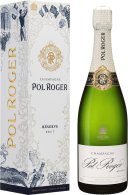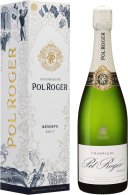Laherte Frères Brut Champagne Non-Vintage
The distinctive, geologically complex terroir of Chavot and the Coteaux Sud d'Épernay in general is very different to the Côte des Blancs and Montagne de Reims areas where our other growers are based, and the style of wine is creamier and with more fruit.
Philipponnat Blanc de Noirs Extra-Brut Vintage
PHILIPPONNAT Blanc de Noirs Extra-Brut Vintage, Champagne
Pommery Cuvée Louise half
Created in homage to Louise Pommery, daughter of Madame Pommery, Cuvée Louise is a wine of exceptional and absolute purity which expresses the quintessence of the knowhow of the Maison Pommery.Cuvée Louise finds its origin within three grands crus; Avize, Cramant and Aÿ - true gems of the Champagne region.The 2006 vintage, uniquely available in half bottle size, expresses all its lightness and delicacy with subtle minerality. The harmony is perfect. Aromas of white flowers are wonderfully associated with hints of prunes and white peaches, creating a silky and fine effect. It embraces the palate with grace and elegance, the finale is long and tense.
Piper-Heidsieck Vintage Brut
This Peper-Heidsieck 2006 Vintage Brut is an elegantly charming wine. With aromas of dried fruits, hints of red and black fruits and warm spices, it is intense and enticing on the nose. A densely structured wine, it has generous fruits on the palate with a touch of smoked tea and toasted almonds leading towards a lengthy finish.
Laherte Frères Blanc de Blancs Nature Champagne Non-Vintage
Laherte Frères Blanc de Blancs Nature is made with the best parcels of Chardonnay (located on the south slopes of Epernay and the Côte des Blancs). This wine is very representative of the purity and the minerality of the Chardonnay.
Taittinger Brut Réserve Champagne
Typical of the Taittinger "house" style, their non vintage Champagne is superbly well-balanced and easy to drink. Smoothly textured with delicate fruit flavours and subtle toasty yeast characters it is an ideal aperitif.
Pol Roger Brut
An impressively rich, dry style from one of the oldest and most distinguished Champagne houses. Pol Roger Brut is perfect both as an occasion wine or for impromptu celebrations.
Billecart-Salmon Brut Sous Bois
This unique cuvýe is respectfully composed of the three champenois grape varieties - Chardonnay, Pinot Noir and Pinot Meunier. Entirely vinified in oak, Sous Bois (under wood) totally masters the art of blending by renewing the ancestral spirit and savoir-faire of the original Champagnes. The nose contains defined aromatics of dry fruits and fresh citrus, coupled with finely buttered seductive notes that expresses the mature complexity linked to the vinification in oak barrels. The palate is bursting with flavours of grilled brioche, vanilla and toffee, complimenting the refreshing texture and exceptional finish.
Billecart-Salmon Brut Blanc de Blanc
This Chardonnay cuvee has been elaborated from five grand cru vineyards of the Cote des Blancs with the blend of this wine coming from two different years. The palate reveals the special qualities of Chardonnay - rich and creamy with buttered brioche. The finish is utterly persistent with a fresh and elegant sweetness.
Veuve Clicquot Non-Vintage Rose
Elegant and fruity, this wine frees the senses, charms the eye and ravishes the palate. Proudly bearing the imperial red signature of Madame Clicquot. It is a delicious rosé Champagne with plenty of character. 'THIS is one of the go-to French brands for a Valentine's moment. It's all about the name, the sunset brushstroke of this rose´ and its abundant presence in the glass. There is a cherry to redcurrant-fruit focus and even a background note of sarsaparilla.' - Herald Sun, Melbourne, 12 Feb 2013












